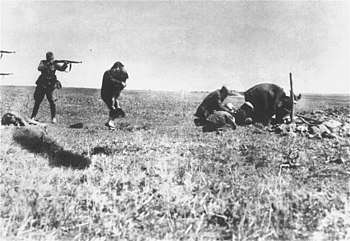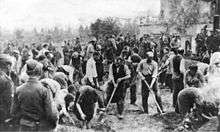The Holocaust in Ukraine
The Holocaust in Ukraine took place in Reichskommissariat Ukraine, General Government, Crimean General Government and some areas under military control to the East of Reichskommissariat Ukraine (all occupied by Nazi Germany) as well as Transnistria Governorate and Northern Bukovina (both occupied by Romania) and Carpatho-Ukraine (occupied by Hungary) in World War II.[5] Between 1941 and 1944 more than a million Jews living in the Soviet Union were murdered by Nazi Germany's Generalplan Ost and the Final Solution extermination policies. Most of them were killed in Ukraine because most pre-WWII Soviet Jews lived in the Pale of Settlement, of which Ukraine was the biggest part.
| The Holocaust in Ukraine | |
|---|---|
 SS paramilitaries murder Jewish civilians, including a mother and child, in 1942, at Ivanhorod, Ukraine. | |
| Location | |
| Date | 22 June 1941 to 1944 |
| Incident type | Imprisonment, mass shootings, concentration camps, ghettos, forced labor, starvation, torture, mass kidnapping |
| Perpetrators | Erich Koch, Friedrich Jeckeln, Otto Ohlendorf, Paul Blobel and many others. Various local Nazi collaborators, including the Organization of Ukrainian Nationalists[1][2][3][4] |
| Organizations | Einsatzgruppen, Ordnungspolizei, and others |
| Victims | 3,700,000 civilians |
| Memorials | At various points in country |
According to Yale historian Timothy D. Snyder, "the Holocaust is integrally and organically connected to the Vernichtungskrieg, to the war in 1941, and is organically and integrally connected to the attempt to conquer Ukraine."[6]
Generalplan Ost
One of Hitler's ambitions at the start of the war was to exterminate, expel, or enslave most or all Slavs from their native lands so as to make living space for German settlers.[7] This plan of genocide[8] was to be carried into effect gradually over a period of 25–30 years.[9]
According to historian William W. Hagen, "Generalplan Ost . . . forecast the diminution of the targeted east European peoples' populations by the following measures: Poles – 85%; Belarusians – 75%; Ukrainians – 65%; Czechs – 50%. ... The Russian people, once subjugated in war, would join the four Slavic-speaking nations whose fate Generalplan Ost foreshadowed."[7]
Death squads (1941–1943)

Total civilian losses during the war and German occupation in Ukraine are estimated at four million, including up to a million Jews who were murdered by the Einsatzgruppen, the Order Police battalions, Wehrmacht and local Nazi collaborators. Einsatzgruppe C (Otto Rasch) was assigned to north and central Ukraine, and Einsatzgruppe D (Otto Ohlendorf) to Moldavia, south Ukraine, the Crimea, and, during 1942, the north Caucasus. According to Ohlendorf's testimony at the Einsatzgruppen Trial, "the Einsatzgruppen had the mission to protect the rear of the troops by killing the Jews, Romani, Communist functionaries, active Communists, uncooperative slavs, and all persons who would endanger the security." In practice, their victims were nearly all Jewish civilians (not a single Einsatzgruppe member was killed in action during these operations). The United States Holocaust Memorial Museum tells the story of one survivor of the Einsatzgruppen in Piryatin, Ukraine, when they killed 1,600 Jews on 6 April 1942, the second day of Passover:
I saw them do the killing. At 5:00 p.m. they gave the command, "Fill in the pits." Screams and groans were coming from the pits. Suddenly I saw my neighbor Ruderman rise from under the soil … His eyes were bloody and he was screaming: "Finish me off!" … A murdered woman lay at my feet. A boy of five years crawled out from under her body and began to scream desperately. "Mommy!" That was all I saw, since I fell unconscious.[10]

From 16–30 September 1941 the Nikolaev massacre in and around the city of Mykolaiv resulted in the deaths of 35,782 Soviet citizens, most of whom were Jews, as was reported to Hitler.[11]
-- Order posted in Kiev in Russian and Ukrainian on or around September 26, 1941.[12]
The most notorious massacre of Jews in Ukraine was at the Babi Yar ravine outside Kiev, where 33,771 Jews were killed in a single operation on 29–30 September 1941. (An amalgamation of 100,000 to 150,000 Ukrainian and other Soviet citizens were also killed in the following weeks). The mass killing of Jews in Kiev was decided on by the military governor Major-General Friedrich Eberhardt, the Police Commander for Army Group South (SS-Obergruppenführer Friedrich Jeckeln) and the Einsatzgruppe C Commander Otto Rasch. It was carried out by a mixture of SS, SD and Security Police. On the Monday, the Jews of Kiev gathered by the cemetery, expecting to be loaded onto trains. The crowd was large enough that most of the men, women, and children could not have known what was happening until it was too late: by the time they heard the machine-gun fire, there was no chance to escape. All were driven down a corridor of soldiers, in groups of ten, and then shot. A truck driver described the scene:
[O]ne after the other, they had to remove their luggage, then their coats, shoes, and overgarments and also underwear … Once undressed, they were led into the ravine which was about 150 meters long and 30 meters wide and a good 15 meters deep … When they reached the bottom of the ravine they were seized by members of the Schutzmannschaft and made to lie down on top of Jews who had already been shot … The corpses were literally in layers. A police marksman came along and shot each Jew in the neck with a submachine gun … I saw these marksmen stand on layers of corpses and shoot one after the other … The marksman would walk across the bodies of the executed Jews to the next Jew, who had meanwhile lain down, and shoot him.[12]
Collaboration in Ukraine
The National Geographic reported:
A number of Ukrainians had collaborated: According to German historian Dieter Pohl, around 100,000 joined police units that provided key assistance to the Nazis. Many others staffed the local bureaucracies or lent a helping hand during mass shootings of Jews. Ukrainians, such as the infamous Ivan the Terrible of Treblinka, were also among the guards who manned the German Nazi death camps.[13]
According to The Simon Wiesenthal Center (in January 2011) "Ukraine has, to the best of our knowledge, never conducted a single investigation of a local Nazi war criminal, let alone prosecuted a Holocaust perpetrator."[14]
According to the Israeli Holocaust historian Yitzhak Arad, "In January 1942 a company of Tatar volunteers was established in Simferopol under the command of Einsatzgruppe 11. This company participated in anti-Jewish manhunts and murder actions in the rural regions."[15]
According to Timothy Snyder, "Something else to remember: the majority, probably the vast majority of people who collaborated with the German occupation were not politically motivated. They were collaborating with an occupation that was there, and which is a German historical responsibility."[16]
Death toll
Until the fall of the Soviet Union, it was believed that about 900,000 Jews were murdered as part of the Holocaust in Ukraine. This is the estimate found in such respected works as The Destruction of the European Jews by Raul Hillberg. In the late 1990s, access to Soviet archives increased the estimates of the prewar population of Jews and as a result, the estimates of the death toll have been increasing. In the 1990s, Dieter Pohl estimated 1.2 million Jews murdered, and more recent estimates have been up to 1.6 million. According to American historian Wendy Lower, "there were many perpetrators, albeit with different political agendas, who killed Jews and suppressed this history".[17]
Executor units
- Einsatzgruppen C & D (Einsatzkommando)
- Abwehr/Brandemburg special saboteur unit Nachtigall Battalion
- Freiwilligen-Stamm-Regiment 3 & 4 (Russians & Ukrainians)
- Ukrainian auxiliary units:[18] Schutzmannschaft as well as Ukrainische Hilfspolizei
Survivors
.jpg)
Rescuers
Ukraine rates the 4th in the number of people recognized as "Righteous Among the Nations" for saving Jews during the Holocaust, with the total of 2,515 individuals recognized as of 1 January 2015.[20]
The Shtundists, an evangelical Protestant denomination which emerged in late 19th century Ukraine, helped hide Jews.[21]
Massacres
- Babyn Yar
- Bila Tserkva
- Dnipropetrovsk
- Feodosiya
- Ivano-Frankivsk
- Klevan
- Lviv pogroms
- Massacre of Lviv professors
- Mezhirichi
- Mizoch
- Nikolaev massacre
- Olyka
- Plyskiv
- Terebovl
- Zhytomyr
See also
- Einsatzgruppen trial
- Gas van
- History of the Jews in Ukraine
- Hegewald, a short-lived German Colony near Zhytomyr
- No Place on Earth, a 2012 documentary film on a group of Ukrainian Jews who survived the height of The Holocaust in the Verteba and Priest's Grotto caves
References
- Grzegorz, Rossolinski (2014). Stepan Bandera : the life and afterlife of a Ukrainian nationalist : Fascism, genocide, and cult. Stuttgart, Germany: Ibidem-Verlag. ISBN 9783838206868. OCLC 880566030.
- 1926-, Arad, Yitzhak (2009). Holocaust in the Soviet Union. Lincoln: University of Nebraska Press. p. 89. ISBN 9780803222700. OCLC 466441935.CS1 maint: numeric names: authors list (link)
- "Nazikollaborateur als neuer Held der Ukraine - Jüdische Gemeinde zu Berlin". www.jg-berlin.org (in German). Retrieved 5 January 2018.
- Himka, John-Paul. "The Lviv Pogrom of 1941: The Germans, Ukrainian Nationalists, and the Carnival Crowd". Cite journal requires
|journal=(help) - Gregorovich, Andrew (1995). "World War II in Ukraine: Jewish Holocaust in Ukraine". Reprinted from FORUM Ukrainian Review (92).
- "Timothy Snyder: Germany must own up to past atrocities in Ukraine". Retrieved 5 July 2017.
- Hagen WW (2012). German History in Modern Times: Four Lives of the Nation. Cambridge: Cambridge University Press. p. 313.
- DIETRICH EICHHOLTZ "»Generalplan Ost« zur Versklavung osteuropäischer Völker"
- Madajczyk, Czesław. "Die Besatzungssysteme der Achsenmächte. Versuch einer komparatistischen Analyse." Studia Historiae Oeconomicae vol. 14 (1980): pp. 105-122 in Hitler's War in the East, 1941-1945: A Critical Assessment by Gerd R. Ueberschär and Rolf-Dieter Müller
- Berenbaum, Michael (2006). The World Must Know. Contributors: Arnold Kramer, USHMM (2nd ed.). USHMM / Johns Hopkins Univ Press. ISBN 978-0801883583.CS1 maint: ref=harv (link) P. 93.
- Hemme, Amira Lapidot (2012). "Jewish History of Mykolayiv (Nikolayev), Kherson Gubernia". JewishGen. Retrieved 29 December 2014.
- Berenbaum 2006, pp. 97-8.
- "President Putin Has Called Ukraine a Hotbed of Anti-Semites. It's Not.". National Geographic. May 30, 2014
- Nazi-hunters give low grades to 13 countries, including Ukraine, Kyiv Post (12 January 2011)
- Arad, Yitzhak (2009). The Holocaust in the Soviet Union. U of Nebraska Press. p. 211. ISBN 978-0-8032-2270-0.
- Germans must remember the truth about Ukraine – for their own sake, Eurozine (7 July 2017)
- Lower, Wendy. "Introduction: the Holocaust in Ukraine". Holocaust and Genocide Studies: 3.
- "Mobile Killing Squads". United States Holocaust Memorial Museum (USHMM)
- Petelycky, Stefan (1999). Into Auschwitz, for Ukraine (PDF). Kashtan Press. ISBN 978-1-896354-16-3.
- "Names and Numbers of Righteous Among the Nations - per Country & Ethnic Origin, as of January 1, 2015". Yad Vashem. Retrieved 12 December 2015.
- Snyder, Timothy (2015). Black Earth: The Holocaust as History and Warning. Crown/Archetype. p. 328. ISBN 978-1-101-90346-9.
External links
- Tango of Death. A True Story of Holocaust Survivors — Mr. Mintz Publishing, Mikhail Baranovskiy, 2020. - ISBN 979-8620147014
- The Holocaust in Ukraine: New Sources and Perspectives, Center for Advanced Holocaust Studies of the United States Holocaust Memorial Museum, Conference Papers, 2013
- Holocaust, Fascism, and Ukrainian History: Does It Make Sense to Rethink the History of Ukrainian Perpetrators in the European Context, published by the American Association for Polish-Jewish Studies, April 2016.